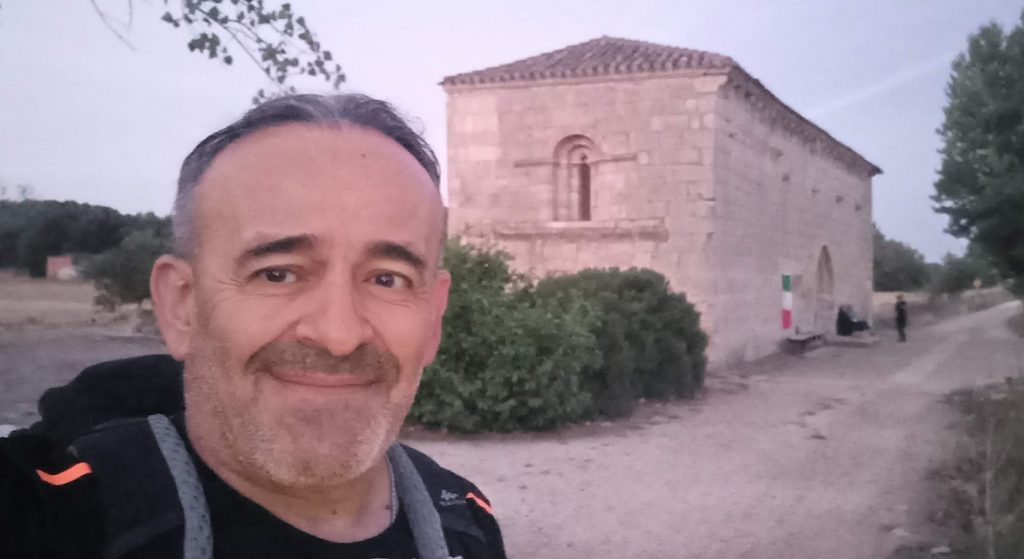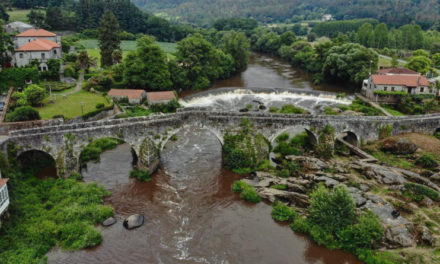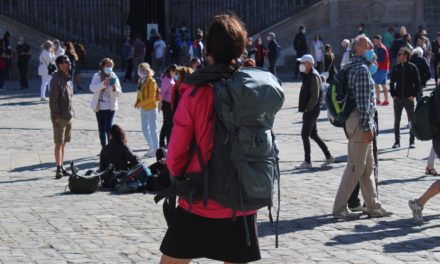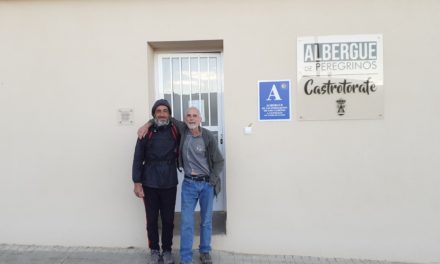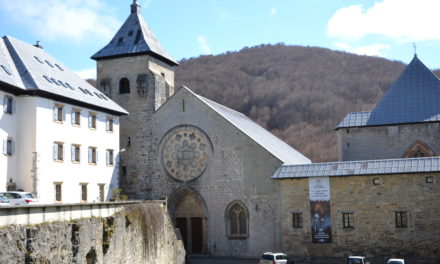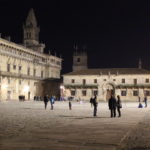Fran Lucas Herrero is a pilgrim originally from Zaragoza who, for some time, has shared his experiences on the Camino through a blog and social networks. He has recently taken another step in his work to disseminate the Camino de Santiago by publishing his first book: “In Itinerae Stellae. Walking the Camino de Santiago Aragonés”. It is a book about the Aragonese branch of the French Way, a very particular book, which combines Jacobean history and tradition with the personal testimony of his experiences as a pilgrim on the Aragonese Way. With this interview we seek to know a little more about the author and contribute to promoting a section of the Camino of enormous historical and patrimonial wealth, a section that still offers pilgrims the possibility of living the experience of a more solitary and peaceful pilgrimage.
At Fundación Jacobea we are very interested in personal experiences, which is why my first question does not refer to the subject of the book but to the author… How did you get to the Camino de Santiago? How was your first encounter with the Camino?
-My first physical contact with the Camino (although its history I knew much better) was more than 20 years ago, when in the years that I spent the summer in Galicia I saw pilgrims walk to or arrive in Santiago. That vision penetrated me, it caused me inner restlessness and around 2007 I had my first contact as a pilgrim, walking from Sarria to Santiago. I was amazed and totally hooked, and by the second time I had already travelled from Roncesvalles to Santiago, and until today.
The Camino has become part of your life, I think you have come to do a pilgrimage even 5 or 6 times in the same year… What paths have you traveled? How much weight has your Aragonese origin had in your choice of itineraries?
-The French several times, the Primitivo twice, the one from Salvador, the Portuguese, the English two, the one from the Ebro, the Aragonese a lot, the Vadiniense and several more, apart from sections to Santiago from Burgos, León, Logroño, Orense and many other towns. Before, I had less time for work or family reasons and I went two or three times a year, but in recent years I have had full time for myself, so I have completed complete paths in one go, completed others several times and numerous stretches of various hundreds of kilometers in others. Due to my Aragonese origin and knowing it very well, I love the Aragonese Way, since it is one of the best Jacobean routes there is, and that is why I walk it so much and try to get people to know it a little more, since it is undervalued.
Those of us who have been linked to the Camino for some time know well how important it is for pilgrims to share their experience… Was your blog born in this way? What desire led you to decide to write your book?
-The blog and everything else was because of my son, who, when dedicating himself to this world of computer science and editorial work, decided to give me a website, that of <esmicamino.es>, a place for me to share my experiences and everything else . Writing I have always been writing, although I have always been in the field of short stories, collaborations, studies and so on. The book is something that was proposed to me by an Association that is very attached to Aragon and there it is, although I would have liked it to have more pages, it has remained largely unanswered.
You are mostly a long-distance pilgrim, with many long-distance paths behind you, so I am interested in your opinion about the last stages before arriving in Santiago. I have heard a really interesting opinion from you about those last stages that I would like you to repeat here…
-Yes, for me the last stages that other pilgrims -who want a custom-made Camino- seem to hate, those from Sarria to Santiago, are the best, they have their own essence and it is a joy to walk them over and over again. I have no problems with what they call overcrowding or the word “turigrino”, a term that I have never used, since the Camino belongs to everyone. People don’t bother me, I go my way and they go theirs, and I have never been in a hurry to secure a place to spend the night, because if there isn’t room in one place there will be another somewhere else. Apart from leaving early to finish walking at 12 this is not my thing. I like to extend the stages more, enjoy them, stop, have a drink here and there, to be able to experiment and enjoy what I feel at every moment. And I repeat, the last stages, the ones that many say they avoid, are the best, a stretch that is comfortable to walk, attractive, perfect, with open services. Those who do not like this section can choose among many other Jacobean paths.
Beyond the testimonial, in your book you have done a great job on the Jacobean history and tradition linked to the Camino in Aragón. Could you tell us a bit more about that part of your job?
I have been researching for many years, being interested in and of course traveling the Aragonese Way, given its unsuspected relevance in the forging of what is now Aragon and Spain. In addition, I usually collaborate with some Aragonese media and other places, at the same time that I collaborate and help for free with various studies and other issues related to the Camino and other stories from other autonomous communities, which I should prefer to remain anonymous. I have verified more than enough that the fame and infrastructure the French Way from Roncesvalles has, when for me the Aragonese Way from Somport, if it were given an opportunity, if the Aragonese authorities and other institutions knew how to sell it, more pilgrims would travel it, even if it will lose its calm essence.
You have chosen to share your experiences on the Camino Aragonés in this book. Could you summarize a little what it has meant for you to walk that section of the Camino?
-It is pure magic, a marvel, an enjoyment, a joy, something beautiful, pleasant and magical, apart from pure history, to travel the Aragonese Way over and over again, enjoy the landscapes, the gastronomy, its people, the wonder of the Romanesque that it treasures and everything that can be said about a Jacobean route with so much historical weight. In short, if I didn’t enjoy walking it as I do, feeling its essence, I wouldn’t go back to it as often as I do.
I would like you to dwell on your two aspects- as a pilgrim and as the author of a historical investigation on the Camino in Aragón When you introduce that part of the Camino to a pilgrim who considers walking it: what will he find? What do you recommend him to do or visit?
-You will find beauty, history, gastronomy, good people and many more things, because if you come open to discover it with your five senses and with your soul, it is a Jacobean route that you will not forget, but the best is what you will take with you walking it with an open mind and spirit. It would take too long to recommend something, because it would be very long, but the first stage from Somport to Jaca is more than unique and magical, with that descent through the Valle del Aragón, the cathedral of San Pedro, and then the old monastery of San Juan de la Peña, which is more than a priority to visit, and also Artieda, Santa Cruz de la Serós, Ruesta, and many more places. The list is too long to define here.
The historical importance of the Aragonese Way or Aragonese branch of the French Way is enormous, which inevitably forces us to ask ourselves the question of why it is not as frequented as the Navarrese branch. To what extent has the territory, geography or distances been decisive? What weight do you think the available infrastructures or the work of the Public Administrations have?
-It is not as frequented because it has never been given the importance and value it deserves, both by the administration and by many pilgrims, since for many the only Camino begins in SJPDP and if you do not start it there then you have not done the Camino . Well, I haven’t started nor will I ever start from there, and I’ve done it lots of times since Somport and Roncesvalles, and I’m still so happy here. It is clear that the Aragonese Way cannot compete in services with the French Way from Roncesvalles, but in history and beauty it equals and surpasses it. It’s like everything in this life, a matter of taste, publicity, sensations and everything like that.
There are Jacobean associations in Aragon, some with a long history and a lot of work behind them, like the one in Jaca, there is also an important association in your city of Zaragoza… do you collaborate with them? Do you think that the Jacobean association could help the Aragonese Way to be better known and more travelled?
-Associating or undertaking joint or group actions are always beneficial, that is the case of Arrés, although many other times the expected results are not obtained. As I have said, I collaborate with various organizations and associations, but specifically with the one in Zaragoza I do not. This is not for any particular reason, it simply has not been the case, but I greatly appreciate your magnificent work. Also review the magnificent work of the Association of Friends of the Camino de Santiago de Jaca, I have not had the pleasure of meeting them personally, but I know that they do a good job within the means available to them. What would help the Aragonese Way to be better known is to believe in it more and, of course, for the regional administration to invest a little, but only a little, because even though it says it does, I can’t see very clearly the results of what it does.
I would like to ask you about your future projects, as a pilgrim and also as a writer on the Camino. Are you thinking of going on a pilgrimage again in next year 2023? Are you planning to continue writing or researching the Camino?
-Life, apart from being short, is only one and all dreams are valid, so I dream of continuing to walk as long as life allows me to. Yes, I will surely start walking in January, and from there a whole year ahead, where I will surely walk several times. And yes, of course, I will continue writing, as I have been doing for years now, about the Camino, since when you like something, why leave it? There are very interesting projects in progress that I hope will come to fruition for the dissemination and promotion of the Camino de Santiago.
And finally, beyond the projects you are working on: what remains to be accomplished on the Camino? What wish or dream do you still want to achieve?
-On the Camino I still have to fulfill everything, because every time my steps lead me there, it is as if it were the first time, I still feel that strength and that magic that hooked me, and as long as it is like that I will be an unrepentant pilgrim walker. Other dreams, whether or not with the Camino, are those that I still want to achieve while I am still alive, but I cannot say them out loud. I wait and see if we find the apple of happiness, and we bite into it and the happiness comes true. A hug and good Camino always.

